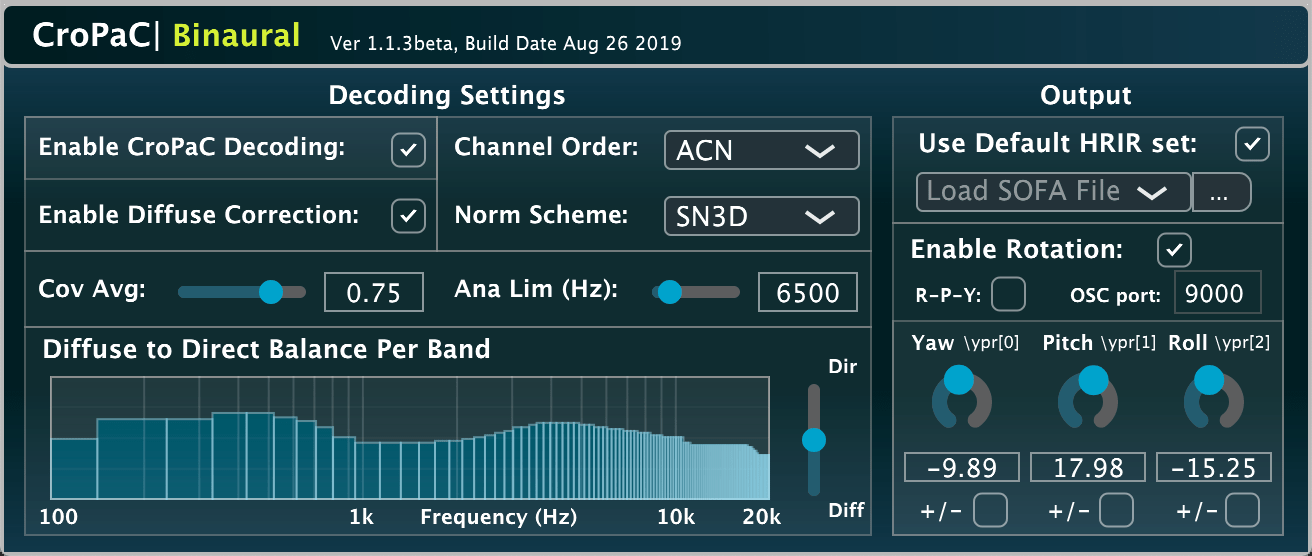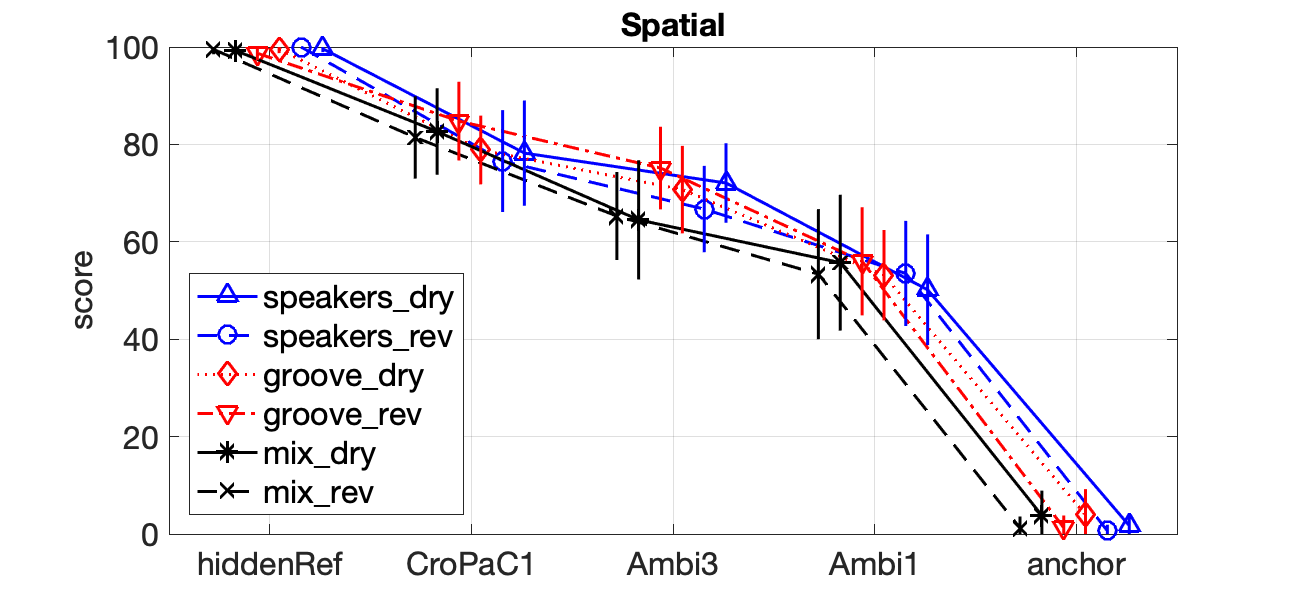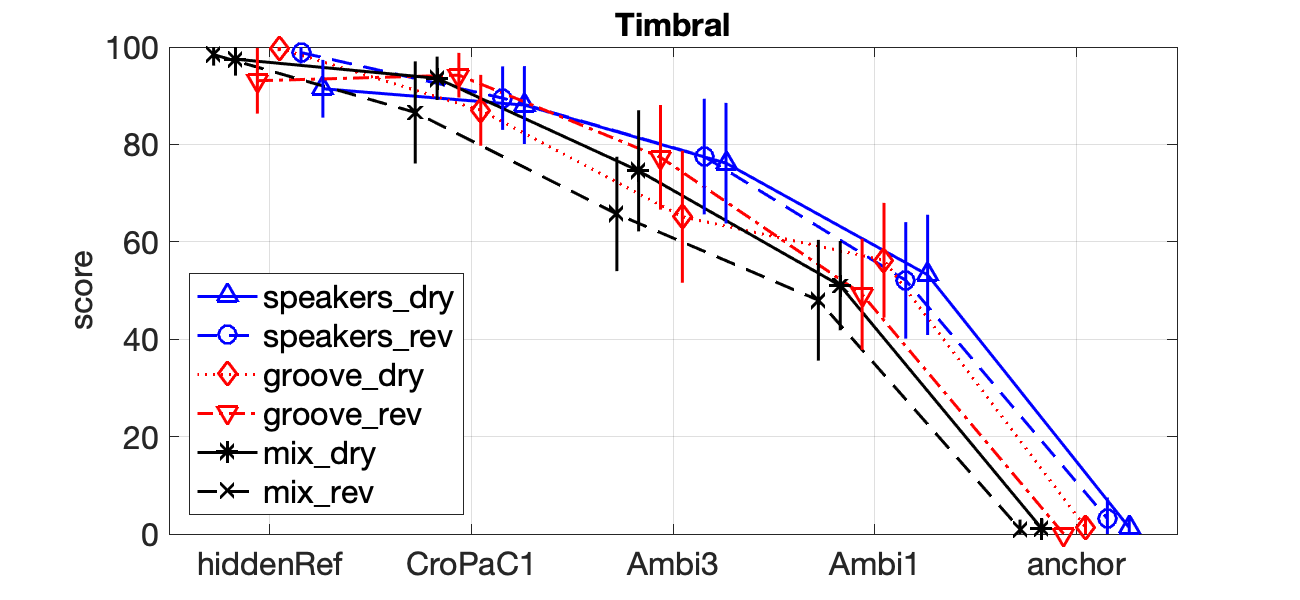CroPaC-Binaural
Plug-in description for the CroPaC binaural decoder.
Paper abstract
Binaural ambisonics decoding is a means of reproducing a captured or synthesised sound-field, as described by a spherical harmonic representation, over headphones. The majority of ambisonic decoders proposed to date are based on a signal-independent approach; operating via a linear mapping between the input spherical harmonic signals and the output binaural signals. While this approach is computationally efficient, an impractically high input order is often required to deliver a sufficiently accurate rendition of the original spatial cues to the listener. This is especially problematic, as the vast majority of commercially available Ambisonics microphones are first-order, which ultimately results in numerous perceptual deficiencies during reproduction. Therefore, in this paper, a signal-dependent and parametric binaural ambisonic decoder is proposed, which is specifically intended to reproduce first-order input with high perceptual accuracy. The proposed method assumes a sound-field model of one source and one non-isotropic ambient component per narrow-band. It then employs the Cross-Pattern Coherence (CroPaC) post-filter, in order to segregate these components with improved spatial selectivity. Listening test results indicate that the proposed method, when using first-order input, performs similarly to third-order Ambisonics reproduction.
The full paper can be found here →
Overview of the method
The proposed first-order decoder employs a sound-field model comprising one source component and one non-isotropic ambient component per time-frequency tile. The method first estimates the source DoA via steered-response power (SRP) beamforming and subsequent peak-finding. The source stream is then segregated by steering a beamformer toward the estimated DoA, and employing an additional CroPaC [1] post-filtering operation to improve its spatial selectivity. The ambient stream is then simply the residual, once the source component has been subtracted from the input sound-field. The two streams are then binauralised and fed into an optimal mixing unit [2], along with the ambisonic prototype covariance matrix, in order to generate the binaural output. A block diagram of the proposed method is depicted below:

The proposed approach is inspired by the COMPASS method [3]. However, along with the CroPaC post-filter, it also employs instantaneous source direction estimation and synthesises the output in a linear manner as much as possible; in order to improve the fidelity of the output signals.
Plug-in description

This implementation employs the magnitude least-squares (magLS) ambisonic decoder [4] as the prototype, contrary to the spatial-resampling decoder employed for the listening tests described in the paper. The plug-in allows the user to import their own HRTFs via SOFA files, and also supports head-tracking via OSC messages. The user may also influence the direct/diffuse balance per frequency band; note that the streams are balanced when set in the middle (default).
Listening test results at a glance
Formal listening tests indicate that the proposed first-order decoder (CroPaC1) performs similarly to (or exceeds) third-order spatial re-sampling ambisonics decoding (Ambi3), in terms of the perceived spatial and timbral attributes of the reproduction; as shown in the plots below:


It should be highlighted that third- order ambisonics employs four times the number of input channels than that of the proposed method. This, therefore, represents a significant reduction in bandwidth, without compromising the perceived spatial accuracy or fidelity.
Developers
- Leo McCormack: a doctoral candidate at Aalto University.
- Symeon Delikaris-Manias: post doctorate researcher at Aalto University, specialising in compact microphone array processing for DoA estimation and sound-field reproduction. His doctoral research included work on the Cross-Pattern Coherence (CroPaC) algorithm, which is a spatial post-filter optimised for high noise/reverberant environments.
License
This plug-in may be used for academic, personal, and/or commercial use. The source code may also be used for commercial purposes, provided that the terms of the GPLv3 license are fulfilled. This requires that the original code and/or any derived works must also be open-sourced and made available under the same GPLv3 license, if it is to be used for commercial purposes.
References
[1] Delikaris-Manias, S. and Pulkki, V. (2013). Cross Pattern Coherence Algorithm for Spatial Filtering Applications Utilizing Microphone Arrays.
Audio, Speech, and Language Processing, IEEE Transactions on , vol.21, no.11, pp.2356-2367.
[2] Vilkamo, J., Bäckström, T., and Kuntz, A. (2013). Optimized covariance domain framework for time–frequency processing of spatial audio.
Journal of the Audio Engineering Society, 61(6), 403-411.
[3] Politis, A., Tervo S., and Pulkki, V. (2018) COMPASS: Coding and Multidirectional Parameterization of Ambisonic Sound Scenes.
IEEE International Conference on Acoustics, Speech and Signal Processing (ICASSP).
[4] Schörkhuber, C., Zaunschirm, M., and Höldrich, R. (2018). Binaural Rendering of Ambisonic Signals via Magnitude Least Squares.
In Proceedings of the DAGA (Vol. 44).